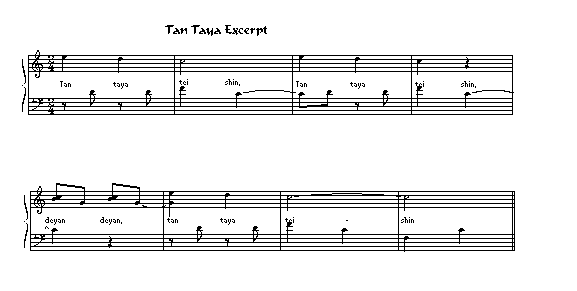
Although Tan Taya is a well known classical court song in the Kyo form, probably because it is the first composition to be learned in the traditional study of Burmese music, it begins by quoting the phonemes associated with some of the basic sounds of Burmese music. The syllable tan indicates a ninth, here broken between the left and right hands, Taya an octave on the finalis pitch, tei, or teyi represents the seventh. Deyan is a falling tone pattern using a third and going from the sixth to the fourth degree. Note that in this example while the ninth, tan, is broken up into two beats, as is the octave, teya, the word teyi, or tei is sung on one beat and as one syllable.
The melodic structure of the particular composition imposes, in this case, the breaking up of the composite sounds, tan and teya, into two separate sounds. Conceptually, however, they still function as musical consonants, a ninth, octave, or as in the case of teyi, either the seventh degree alone or harmonized by a fifth below. Deyan, however, is used to accompany the appearance of the sharp falling tone in the spoken language and some form of this pattern must be played whenever there is a falling tone in the song text. In its clearest form deyan appears as it does here in the song, Tan Teya, as two adjacent tones heard simultaneously followed by a third tone, one degree lower. Deyan is pronounced as one syllable, like teyi. This treatment of the falling tone becomes a fixed part of the composition and must be played or varied, even in purely instrumental performances.
email to rgarfias@uci.edu
last updated 15 October 1995